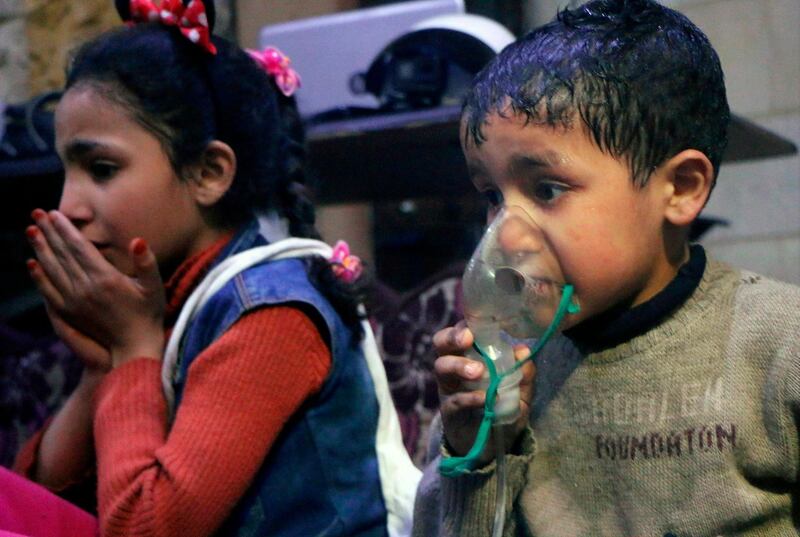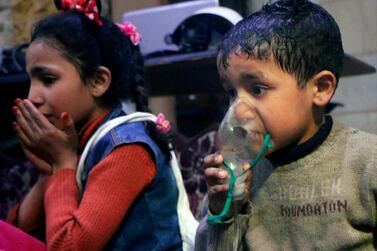The world's chemical weapons watchdog said Friday that chlorine was used against the rebel-held Syrian town of Douma in 2018, in a long-awaited final report on the deadly attack.
The report by the Organisation for the Prohibition of Chemical Weapons (OPCW) was based on a visit by inspectors to the site of the attack which witnesses said killed 43 people.
Western powers led by the United States blamed the regime of Syrian President Bashar Al Assad for the incident and unleashed air strikes on military installations in response.
The Hague-based watchdog said two cylinders likely containing chlorine smashed into a housing block in the town.
The OPCW report said that there were "reasonable grounds that the use of a toxic chemical as a weapon has taken place on 7 April 2018. This toxic chemical contained reactive chlorine."
It said however that it found no evidence of the use of nerve agents in Douma, which had been previously alleged by some parties in the conflict.
The findings confirmed an interim OPCW report released last July saying that traces of chlorine were found.
The report does not place blame because it was not in the OPCW's remit at the time, although the watchdog has since been given powers to investigate responsibility for all chemical attacks in Syria back to 2014.
🔴 BREAKING: #OPCW Issues Fact-Finding Mission Report on Chemical Weapons Use Allegation in #Douma, #Syria, in 2018 https://t.co/WvlZT1Ywl5
— OPCW (@OPCW) March 1, 2019
Russia, which backs Mr Assad, rejected the report and said the attack was "staged" by Syrian rescue volunteers known as the White Helmets.
"In spite of all the evidence presented by Russia, Syria, and even British journalists that the Douma incident is no more than 'White helmets' staged provocation, Technical Secretariat of OPCW states in today's report that chlorine was used in Douma as a chemical weapon," the Russian Embassy in The Hague tweeted.
British Foreign Secretary Jeremy Hunt however said Syria should now honour its 2013 vow to destroy all its chemical weapons, made after 1,400 people were killed in the Damascus suburb of Ghouta in what the UN said was an attack using the nerve agent sarin.
Confirmed today by @OPCW - chemical weapons WERE used in Douma, Syria in April 2018. The Asad regime must cease, declare & destroy its chemical weapon programme. We remain committed to seeking justice for the victims
— Jeremy Hunt (@Jeremy_Hunt) March 1, 2019
A team of OPCW inspectors took more than 100 samples from seven sites in Douma when they gained access to the town after being denied access for several weeks.
The OPCW said it reached its conclusions based on "witnesses' testimonies, environmental and biomedical samples analysis results, toxicological and ballistic analyses from experts".
The report said "two yellow industrial cylinders dedicated for pressurised gas" were found, one of which had landed on top of the housing block and crashed through it.
It said it was "possible that the cylinders were the source of the substances containing reactive chlorine."
The UK's Minister for the Middle East, Alistair Burt, welcomed the report and asked the Assad regime to work with the OPCW to "fully declare and destroy all aspects of its past and current chemical weapons programme".
“The use of chemical weapons cannot be allowed to become normal - either in Syria, on UK streets or elsewhere," he said. "We call on the regime’s backers to use their influence to ensure the regime never uses chemical weapons again."
The OPCW said witnesses told the team there were "43 decedents related to the alleged chemical incident, most of whom were seen in videos and photos strewn on the floor of multiple levels of an apartment building and in front of the same building."
The videos "indicate exposure to an inhalational irritant or toxic substance" and show burns to the eyes and foaming from the mouth, although it could not directly link those to any specific substance.
The watchdog also rejected claims by the Syrian regime that the gas came from an alleged rebel chemical weapons facility and storehouse in the area.
"From the analysis of the information gathered during the on-site visits to the warehouse and facility suspected of producing chemical weapons, there was no indication of either facility being involved in their manufacture," it said.
The report will now go to the UN Security Council.
The OPCW has been at the forefront of investigating chemical attacks during the eight-year Syrian civil war, with investigators previously confirming the use of "chlorine, sulphur mustard, and sarin as chemical weapons" in other incidents.
But the watchdog is now riven by political divisions between Russia and the West, particularly over its new powers to attribute blame.
A nerve agent attack on a Russian ex-spy in the English city of Salisbury in 2018, which the West blamed on Moscow, has further poisoned relations.






